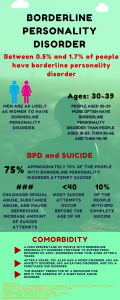What are effective borderline personality disorder treatment options?
There are a lot of borderline personality disorder treatment options, but for most people it’s very difficult to figure out which treatment options are effective and which are not better than placebo (a placebo does not contain a working substance to affect health. A placebo could be a pill, liquid or treatment). Unlike some other mental disorders, medication cannot be used to treat borderline personality disorder (BPD). It can reduce symptoms of anxiety and depression, but medication can’t be used for treating BPD [1]. On this page effective borderline personality disorder treatment options are discussed. Also a brief explanation of each psychotherapy is being given.
Jump to:
- What is borderline personality disorder?
- What causes Borderline personality disorder?
- How is borderline diagnosed?
- Borderline personality disorder self-test.
- Coping with BPD yourself.
- Living with someone who has BPD.
- Interesting borderline personality disorder facts.
- Online counseling for Borderline personality disorder.
- Take me to the homepage.
At Barends Psychology Practice we offer (online) therapy for borderline personality disorder. Contact us to schedule a first, free of charge, online session. (Depending on your health insurance, treatment may be reimbursed).
Borderline personality disorder treatment: most often used BPD treatments.
There are approximately three evidence based borderline personality disorder treatment types: Dialectical behaviour therapy (DBT), Schema focused therapy (SFT), and Transference-focused therapy (TFT). Of course, there is also medication, but this won’t cure borderline personality disorder. All medication does is reducing the severity of the BPD symptoms, and the moment you quit medication the BPD symptoms come back again. However, medication can be an effective addition to the previously mentioned therapies for BPD, especially when someone’s BPD is very severe. Medication can reduce anxiety levels or depression levels which increases the chance that the patient will benefit from counseling. In the next paragraphs the most effective therapy types for BPD are being discussed. Also the effectiveness of medication is being discussed.
- 1. Schema focused therapy (SFT). Schema focused therapy is effective in treating borderline personality disorder–specific and general psychopathologic dysfunction [2]. All BPD symptoms reduced in severity. On top of that SFT improves the quality of life of those suffering from BPD, and significant positive changes in personality were reported. A possible explanation for the effectiveness of SFT is that schema focused therapy addresses “the level of personality, not merely the ‘surface’ symptom level” [2]. Compared to transference-focused psychotherapy (TFP), schema focused therapy is superior in everything: the drop-out rate is lower, cost-effectiveness is better for clinical patients [6], and there is a more dramatic reduction of BPD symptoms. The improvements on quality of life are as significant as with TFP [2]. Schema therapy focuses on reducing persistent and old behavioural patterns that someone developed during childhood. These unhealthy behavioural patterns cause a lot of problems. In order to change there behavioural patterns someone needs to practice and analyze behaviour a lot. The therapist helps the patient to correct certain behavioural responses. At Barends Psychology Practice schema focused therapy for Borderline personality disorder is offered. Schedule an appointment here.
- 2. Dialectical behavioural therapy (DBT). Dialectical behavioural therapy is effective in reducing borderline personality disorder symptoms, reducing self-mutilating behaviours, and self-damaging impulsive acts. Its attrition rate is very low as well (only 37% compared to 77% in treatment as usual) [3]. DBT is also effective in reducing suicide attempts [5]. With DBT the patient learns that it is worth it to stay alive, and that it’s important to continue with therapy. After these first steps therapy focuses on the development of skills regarding dealing with emotions, situations and yourself. It is important for the patient to practice and to strengthen the strong sides someone has. For those people with BDP who are suicidal, DBT is the preferred treatment of choice [2].
- 3. Transference-focused psychotherapy (TFP). Transference-focused psychotherapy is effective in treating borderline personality disorder–specific and general psychopathologic dysfunction [2]. All TFP symptoms reduced in severity. On top of that TFP improves the quality of life of those suffering from BPD, and significant positive changes in personality were reported. Although the results of TFP are less impressive as those of SFT (see schema focused therapy above), using TFP to treat BPD is effective. Transference-focused psychotherapy focuses on limit-setting regarding self-harm, and on exploration of one’s thoughts and sense of identity. The theory behind TFP says that these symptoms of BPD have an underlying psychological structure.
(Advertisement. For more information, please scroll down.)
How does medication affect the borderline personality disorder?
In short, borderline personality disorder can’t be treated with medication [1]. However, some symptoms can be reduced using medication. Think of feelings of anxiety and depression that are accompanied with BPD; anxiety and depression can be reduced with medication. This can have a positive influence on the course of psychotherapy (schema therapy, dialectical behavioural therapy and transference-focused therapy). Most people with BPD take antidepressant medication (67%), followed by anxiolytic (28%), antipsychotic (27%), and 22% a mood stabilizer [4].
(Advertisement. For more information, please scroll down.)
Literature used for this article:
12-month, randomised clinical trial in The Netherlands. The British Journal of Psychiatry, 182, 135-140.

